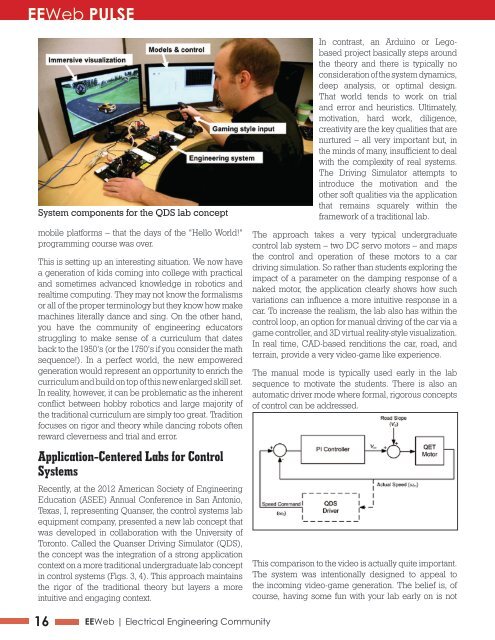Ahmad Bahai - EEWeb
Ahmad Bahai - EEWeb
Ahmad Bahai - EEWeb
You also want an ePaper? Increase the reach of your titles
YUMPU automatically turns print PDFs into web optimized ePapers that Google loves.
<strong>EEWeb</strong> PULSE<br />
System components for the QDS lab concept<br />
mobile platforms – that the days of the “Hello World!”<br />
programming course was over.<br />
This is setting up an interesting situation. We now have<br />
a generation of kids coming into college with practical<br />
and sometimes advanced knowledge in robotics and<br />
realtime computing. They may not know the formalisms<br />
or all of the proper terminology but they know how make<br />
machines literally dance and sing. On the other hand,<br />
you have the community of engineering educators<br />
struggling to make sense of a curriculum that dates<br />
back to the 1950’s (or the 1750’s if you consider the math<br />
sequence!). In a perfect world, the new empowered<br />
generation would represent an opportunity to enrich the<br />
curriculum and build on top of this new enlarged skill set.<br />
In reality, however, it can be problematic as the inherent<br />
conflict between hobby robotics and large majority of<br />
the traditional curriculum are simply too great. Tradition<br />
focuses on rigor and theory while dancing robots often<br />
reward cleverness and trial and error.<br />
Application-Centered Labs for Control<br />
Systems<br />
Recently, at the 2012 American Society of Engineering<br />
Education (ASEE) Annual Conference in San Antonio,<br />
Texas, I, representing Quanser, the control systems lab<br />
equipment company, presented a new lab concept that<br />
was developed in collaboration with the University of<br />
Toronto. Called the Quanser Driving Simulator (QDS),<br />
the concept was the integration of a strong application<br />
context on a more traditional undergraduate lab concept<br />
in control systems (Figs. 3, 4). This approach maintains<br />
the rigor of the traditional theory but layers a more<br />
intuitive and engaging context.<br />
16 <strong>EEWeb</strong> | Electrical Engineering Community<br />
In contrast, an Arduino or Legobased<br />
project basically steps around<br />
the theory and there is typically no<br />
consideration of the system dynamics,<br />
deep analysis, or optimal design.<br />
That world tends to work on trial<br />
and error and heuristics. Ultimately,<br />
motivation, hard work, diligence,<br />
creativity are the key qualities that are<br />
nurtured – all very important but, in<br />
the minds of many, insufficient to deal<br />
with the complexity of real systems.<br />
The Driving Simulator attempts to<br />
introduce the motivation and the<br />
other soft qualities via the application<br />
that remains squarely within the<br />
framework of a traditional lab.<br />
The approach takes a very typical undergraduate<br />
control lab system – two DC servo motors – and maps<br />
the control and operation of these motors to a car<br />
driving simulation. So rather than students exploring the<br />
impact of a parameter on the damping response of a<br />
naked motor, the application clearly shows how such<br />
variations can influence a more intuitive response in a<br />
car. To increase the realism, the lab also has within the<br />
control loop, an option for manual driving of the car via a<br />
game controller, and 3D virtual reality-style visualization.<br />
In real time, CAD-based renditions the car, road, and<br />
terrain, provide a very video-game like experience.<br />
The manual mode is typically used early in the lab<br />
sequence to motivate the students. There is also an<br />
automatic driver mode where formal, rigorous concepts<br />
of control can be addressed.<br />
This comparison to the video is actually quite important.<br />
The system was intentionally designed to appeal to<br />
the incoming video-game generation. The belief is, of<br />
course, having some fun with your lab early on is not















